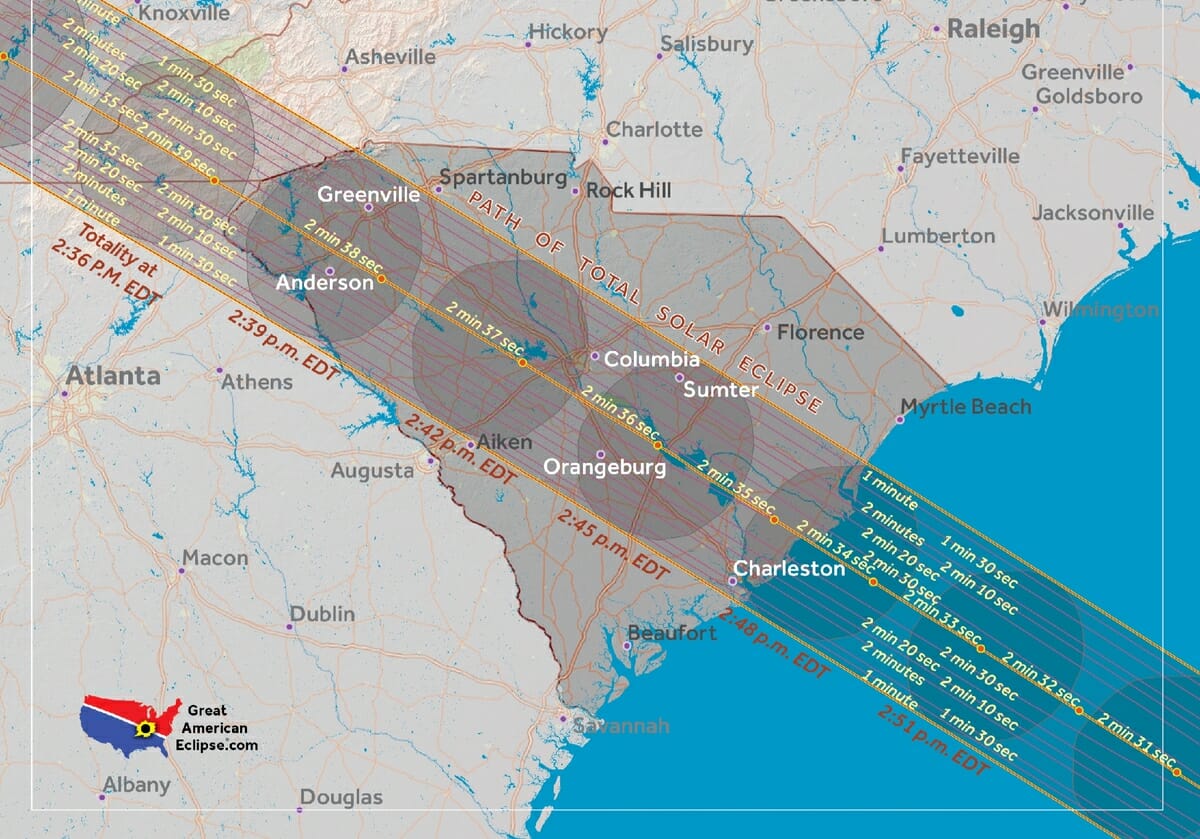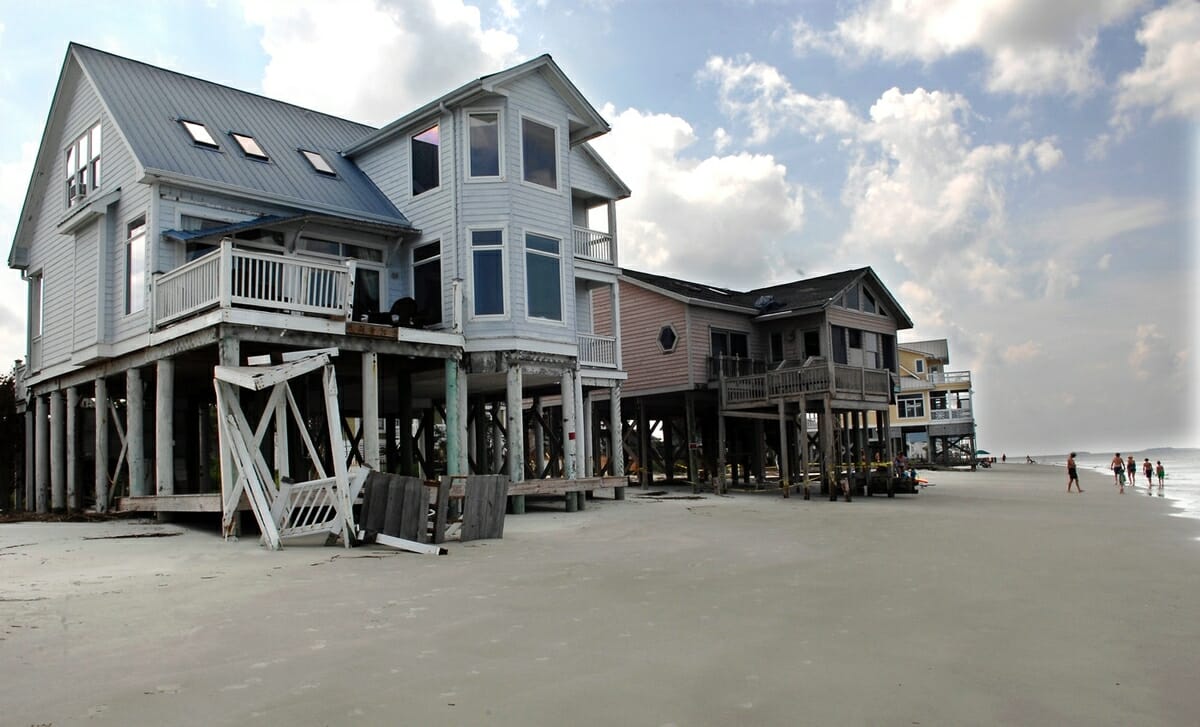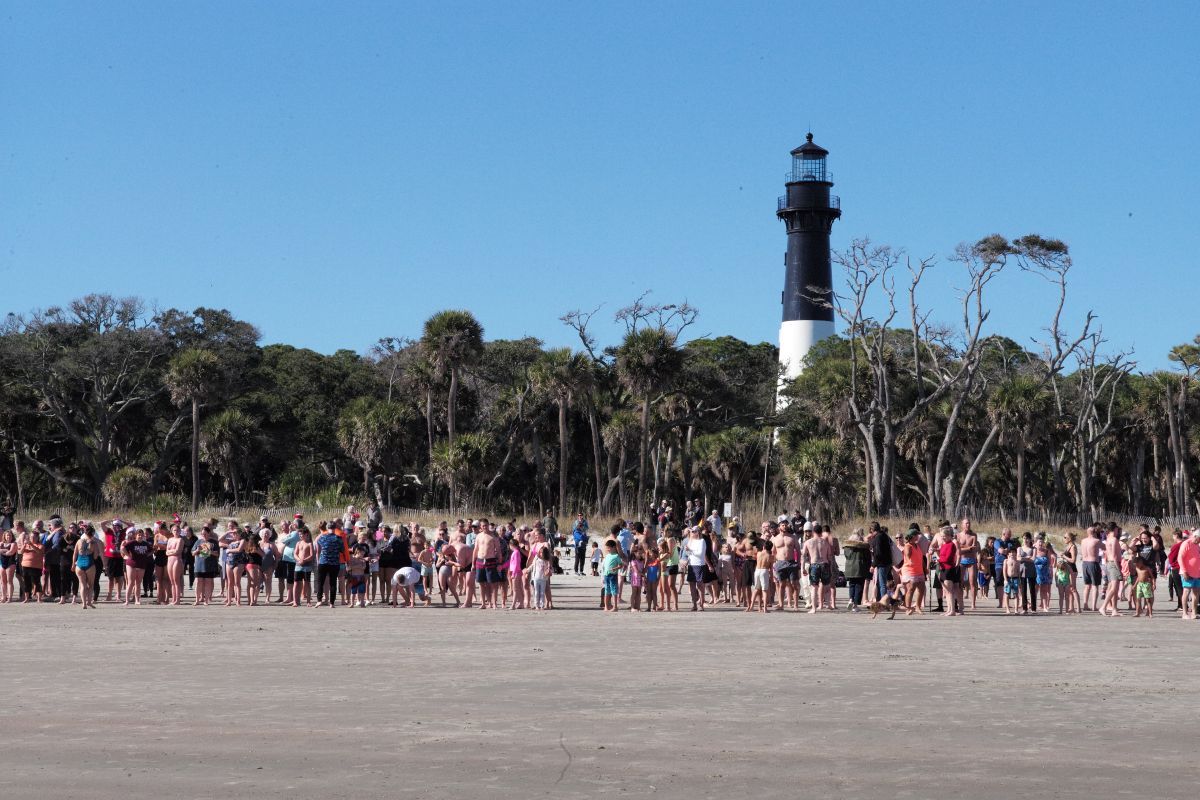Map above courtesy of Michael Zeiler, www.GreatAmericanEclipse.com.
Staff reports
On Monday, Aug. 21, millions of people across the United States will see nature’s most wondrous spectacle: a total eclipse of the sun.
After traversing the United States from Oregon in just 94 minutes, the Great American Eclipse of 2017 will leave the United States at South Carolina.
At about 2:48 p.m. the eclipse will pass over Charleston and the skies there will be dark for about 1 minute and 40 seconds.
Beaufort is outside the path of the eclipse, but it will still be a monumental event here when about 90 percent of the moon will cover the sun.
South Carolina will be a significant destination for the eclipse because it will be the nearest spot within the path of totality for at millions of Americans on the Atlantic seaboard.
“We estimate that South Carolina is the closest destination to 94 million Americans,” according to www.greatamericaneclipse.com. “The bulk of this potential is from the I-95 corridor stretching from New England to Florida and connecting many of the nation’s largest metropolitan areas. We further estimate that between a half a million to 2 million people will travel to the path of totality in South Carolina.”
Here are some questions and answers about the eclipse
Q: What is an eclipse and how should people protect their eyes?
A: According to Dr. Kenneth Farr, of SunGate Medical Group (with locations on St. Helena and in Beaufort, among others), “During the highly anticipated solar eclipse, visitors and residents of South Carolina will experience the longest total eclipse on the East Coast for a metro area.
“A total eclipse occurs when the sun, moon and earth line up so perfectly that the moon blocks the sun, creating rare and spectacular effects across the sky and throughout the natural environment, including darkness in the middle of the day and the elusive ‘corona’ effect around the sun, visible only during a 100 percent total solar eclipse.
“Anyone planning to witness the total solar eclipse will need protective glasses with a special safety film to view the partial eclipse leading up to and following the total eclipse.
“The light of an eclipse has very dangerous capabilities, and can cause solar retinopathy, which is retinal damage that results from exposure to solar radiation. Patients with solar retinopathy may notice a small blind spot in their central line of vision.
“Even if you are not in the path of eclipse totality, you are at risk for eye damage if you will be looking at the sun. Regular sunglasses, even the darkest, will not protect your eyes; everyone should be using special protective glasses.
“Solar eclipse glasses are available at one of our locations.”
Visit www.sungatemedicalgroup.com or call 843-522-9179.
Q: Since Beaufort is not in the direct path, can I use a telescope, binoculars or
a camera?
A: No. According to NASA, people should not look at the uneclipsed or partially eclipsed sun through an unfiltered camera, telescope, binoculars or other optical device.
Similarly, do not look at the sun through any of those devices or any other optical device while using your eclipse glasses or hand-held solar viewer. The concentrated solar rays will damage the filter and enter your eye(s), causing serious injury.
Eclipses are best viewed directly when magnified, which means a telescope with a solar filter or solar telescopes. These will give you a magnified view that will clearly show the progress of an eclipse.
Never look through a telescope without a solar filter on the large end of the scope. And never use small solar filters that attach to the eyepiece (as found in some older, cheaper telescopes).
Q: Can I watch the eclipse if I wear prescription eyeglasses?
A: If you normally wear eyeglasses, keep them on. Put your eclipse glasses on over them, or hold your handheld viewer in front of them.
If your eclipse glasses or viewers are compliant with the ISO 12312-2 safety standard, you can look at the uneclipsed or partially eclipsed sun through them for as long as you wish. Do not use eclipse glasses if they are scratched, punctured or torn.
Q: What if I don’t have eclipse glasses?
A: According to NASA, an alternative method for safe viewing of the partially eclipsed sun is pinhole projection. For example, cross the outstretched, slightly open fingers of one hand over the outstretched, slightly open fingers of the other, creating a waffle pattern. With your back to the sun, look at your hands’ shadow on the ground. The little spaces between your fingers will project a grid of small images on the ground, showing the sun as a crescent during the partial phases of the eclipse.
Or just look at the shadow of a leafy tree during the partial eclipse; you’ll see the ground dappled with crescent suns projected by the tiny spaces between the leaves.
Experts also suggest that one widely available filter for safe solar viewing is welder glasses of sufficiently high number. The only ones that are safe for direct viewing of the sun with your eyes are those of Shade 12 or higher. These are much darker than the filters used for most kinds of welding.
Where to watch
There are several events and celebrations around town on Monday, Aug. 21. They include:
• Eclipse Safari & NASA Live Stream
The St. Helena Branch Library will hold an Eclipse Safari & NASA Live Stream from 10:45 a.m. to 4 p.m.
Guests can watch live eclipse footage and interviews with scientists and astronauts from the international space station, 11 space craft, at least three NASA aircraft, and more that 50 high-altitude balloons.
In addition to viewing the eclipse and the NASA telecast, the library will also have many other interesting activities and experiments including constructing
pinhole viewers.
• Lobeco Branch Library
The library will hold a viewing party at 2:15 p.m. Bring a chair and come by the library to watch the solar eclipse as it happens or view the solar eclipse via livestream inside the library. Light refreshments will be provided.
• Beaufort Academy
Beaufort Academy is offering the public a chance to learn more and watch the eclipse.
There will be science displays, guest speakers, eclipse glasses (while supplies last) and a public viewing of the amazing eclipse at the Beaufort Academy Football Field.
The event will start at 1:30 p.m. at Beaufort Academy at 240 Sams Point Road.
• Beaufort Inn
The Beaufort Inn is offering the opportunity to the public to view the eclipse from the Rooftop Patio of Old Bay Marketplace Loft and Rooftop from 1-3:30 p.m. They will have solar sunglasses available.
The inn will also be hosting a Solar Eclipse Celebration from 8-10 p.m. in Tabby Garden. Tabby Garden is a large garden event venue space located behind the Main Inn on West Street between Port Republic Street and Craven Street in downtown Beaufort.
The outdoor event will feature Michael Ponder and the Steel Rail Express, the same band that opened for Aaron Lewis this past year at the Beaufort Water Festival’s Concert in the Park. There will also be a cash bar available during the event. This event is free and open to the public. The Beaufort Inn asks that you bring your own chair.
• South Carolina ETV
The ETV coverage of the solar eclipse is going to be carried live as a nationwide broadcast. Over 65 percent of public television’s world channels have already committed to carry the one-hour telecast live from 2:30-3:30 p.m. as the eclipse passes above the state before moving over the
Atlantic Ocean.
Using locations from around the state, including live footage from the SC State Museum’s telescope, Charleston, the Columbia Fireflies stadium, and the South Carolina Botanical Garden at Clemson, the SCETV coverage will also be used that evening in a national PBS program recapping the
day’s events.
SCETV stations are listed at scetv.org.
Get your app!
For a variety of apps for Android and Apple devices, visit eclipse.aas.org/resources/apps-software.






